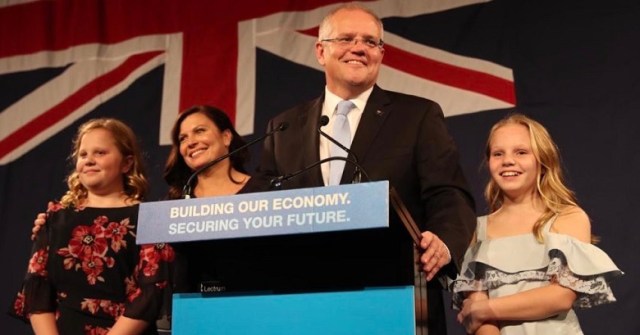
The re-elected Coalition government is set to axe $1.5 billion from the public service in what has been described as a “final insult” to the sector that will see 3,000 jobs go.
The Commonwealth and Public Sector Union (CPSU) says thousands of jobs are set to be slashed from the public service to fund $1.4 billion worth of promises under the Liberal-National alliance’s new majority government.
Treasurer Josh Frydenberg and Minister for Finance and the Public Service Mathias Cormann last Thursday revealed the public service’s efficiency dividend would go from 1.5 per cent in 2021-22 to 1 per cent the following subsequent year – a pledge now set to become policy following the government’s win on Saturday.
The Department of Home Affairs is another big casualty of the Coalition’s plans, with Budget papers revealing plans to cut $150 million next financial year if the government goes ahead with privatising Australia’s visa processing system, which the CPSU says could result in around 2,200 jobs being cut by 2022-23.
Costings from the Coalition estimate the policy will save around $136 million in 2019-20, $379 million in 2020-21 and $506 million in 2021-22.
Public sector efficiencies
In a statement released last week the Liberal Party said the move would drive efficiencies in the public sector.
“Through this policy, the Morrison Government will reduce total departmental expenses over the 2019-20 forward estimates period from $288.6 billion to $287.1 billion, whereas Labor would reduce departmental expenses further to $286.5 billion,” the release says.
The move has been staunchly criticised, with the CPSU slamming the government’s progressive “pillaging” of the public service, warning the latest round of cuts will see at least 3,000 jobs axed.
“These figures show the Coalition is planning to sack at least another 3000 people working in Commonwealth agencies, causing even more damage to essential services the Australian people rely on such as Centrelink and Medicare,” Community and Public Sector Union (CPSU) National Secretary Nadine Flood said in a statement on Thursday.
“The Abbott-Turnbull-Morrison Government has been pillaging the public sector for six years, selling it off to private interests piece by piece, and these 11th hour costings show they’re planning more of the same if they’re re-elected.”
Agencies with staffing levels below 200 will be exempt from the efficiency dividend alongside institutions like the War Memorial, National Archives Australia, the National Library of Australia, SBS, the ABC, Safe Work Australia and the National Gallery.
The exemption currently in place for the Australian Signals Directorate, the Office of National Intelligence and a number of other agencies would also continue.
Labor had promised to hand Commonwealth agencies $500 million while not proceeding with an additional efficiency dividend of 0.5% and scrapping the staffing cap. The opposition argued in their costings that cracking down on the use of contractors would save $2.6 billion over four years.
‘Insult to public sector workers’
The Coalition has previously been criticised for its treatment of the public service, implementing a row of cuts over the past few years, including the introduction of a staffing cap in 2010 which received extensive criticism for prompting widespread use of contractors and the introduction of a freeze on senior public sector member’s salaries.
“This $1.5 billion dollar cut to Commonwealth agencies, putting 3000 jobs at risk, is the Coalition’s final insult to public sector workers and all Australians who rely on the essential services they provide,” Ms Flood said.
The CPSU last week warned the cuts would be damaging for public agencies, potentially exposing them to more mishaps.
“They slash essential services and the jobs to provide them, causing disasters like robo-debt and over 40 million unanswered calls in Centrelink, then use that money to funnel generous contracts to the big end of town.
“Even in the handful of agencies that would be exempt from these Coalition cuts, like the NDIA, their arbitrary cap on staffing numbers will continue to do tremendous damage and hold these agencies from providing the decent services that the general public need and deserve.”
The Coalition told Government News that the efficiency dividend will be rolled out from July this year and refuted the CPSU’s claims that it will result in 3,000 jobs being cut.
Comment below to have your say on this story.
If you have a news story or tip-off, get in touch at editorial@governmentnews.com.au.
Sign up to the Government News newsletter.
3 thoughts on “Re-elected Coalition to slash $1.5b from public service”
Leave a comment:
Most read
Scathing report finds little has changed at PwC
Qld council welcomes progress on massive battery system
‘Local’ procurement turns out not to be so local, committee hears
Another report finds local government falling down on cyber security
MoG changes see regions, investment return to NSW Premier’s Department


Typical of a disinterested government of the needs of the people they are supposed to serve. More like self serving themselves and their fat paycheck.
This has been going on for many years. Once Australia had an Australian Heritage Commission. Now disappeared, and our unique heritage such as the ancient springs that Adani will exploit, once destroyed will never recover.
Every Australian needs to pay attention when evidence is provided that artesian bores are running dry. Never before in my lifetime has this been reported again and again. It is the reality. There is no answer with LNP Inc. in charge.
Forgotten that the “efficiency divided” was started by the working-class hero Robert James Lee Hawke?
Parliamentary Library:
“The efficiency dividend commenced in the 1987–88 financial year. In September 1986 then Prime Minister Hawke announced public service efficiency reforms that included an efficiency dividend of 1.00 per cent per annum for three years commencing in 1987–88:
… departments and agencies will be required to achieve real reductions in the running costs of on-going activities—something like the payment of an efficiency dividend of which the Australian taxpayer will be the ultimate recipient. They will be required to reduce the real level of resources directed to administer existing activities by an average one per cent each year over the next three years, starting in 1987–88 … all government agencies should be able to make continuing efficiency gains by improving their administrative procedures, making better use of improvements in technology and in the use of human resources.[9]
In May 1987, prior to the 1987–88 Budget and the commencement of the efficiency dividend, the government announced that the annual dividend rate would be 1.25 per cent over the 1987–90 period rather than 1.00 per cent.[10] The 1987–88 Budget confirmed the adjusted rate.[“